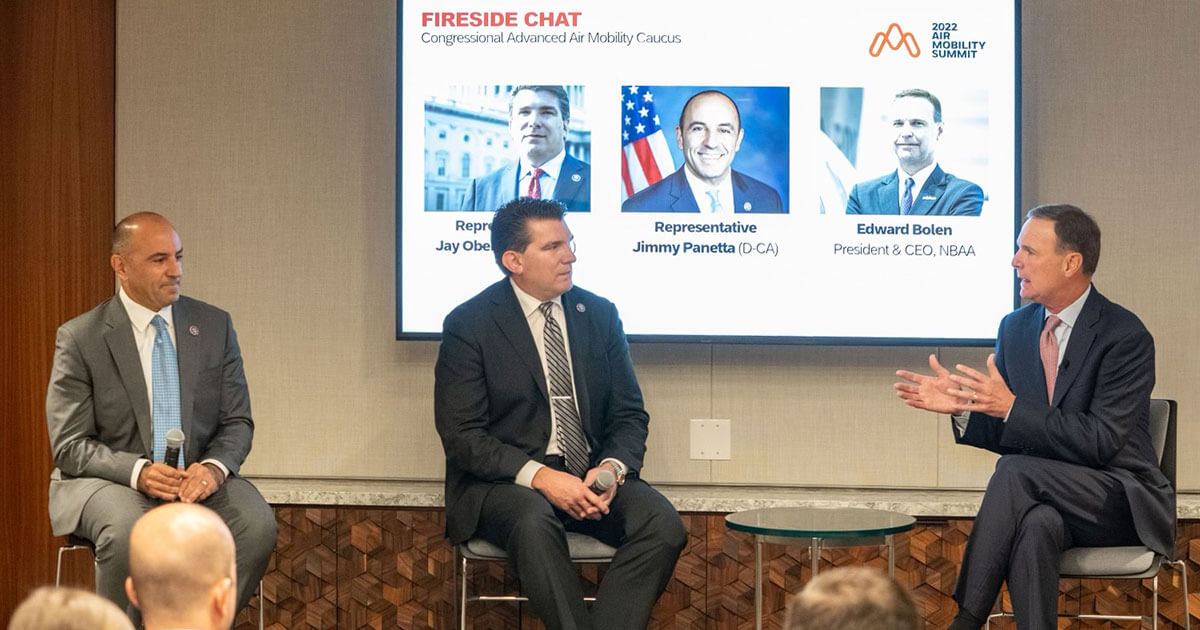
Sept. 21, 2022
Policymakers, regulators, technology leaders and industry stakeholders gathered Sept. 21 for Honeywell’s first-ever Air Mobility Summit to discuss concrete ways to promote action in making the new technology a reality.
“[Advanced air mobility] AAM is the next new mode of transportation and it is playing out today,” said Stéphane Fymat, vice president and general manager, urban air mobility and unmanned aerial systems at Honeywell, in opening up the event, calling it “the most profound change in the aerospace industry, and in people’s lives, since the development of the jet engine.”
As part of the daylong event, NBAA President and CEO Ed Bolen moderated a discussion with congressional AAM Caucus co-chairs Reps. Jay Obernolte (R-8-CA) and Jimmy Panetta (D-20-CA), which touched on the regulatory, infrastructure and safety considerations needed in creating an environment to support AAM.
Obernolte, who is a pilot, predicted AAM would lead to “democratizing aviation – aviation for the masses,” and that once operational throughout the country, it would be not only environmentally friendly, but also cost-effective for many. The U.S., he pointed out, is “well positioned to be the world leader,” in introducing this technology and infrastructure need to support it. “We can do something that the whole world can adopt and follow.”
Panetta added, “When you say ‘AAM’ the room gets full,” and there is a lot of excitement around this technology. But, he said, “We need to make sure government understands and feels this excitement,” and ensure the FAA does its job when it comes to certification.
The U.S. has been a leader in aerospace since the Wright Brothers’ first flight, Bolen noted, adding great countries also have robust transportation systems to connect communities and create economic opportunities. AAM, he said, can improve on what is already in place in the U.S., which has the world’s largest, safest, most efficient and most diverse aviation system.
Panetta agreed, adding that some analysts predict that advanced air mobility will add close to 300,000 jobs in the U.S. by 2035, with the potential to be a $1 trillion industry by 2040.
Both congressmen noted the rural portions of their California districts could benefit greatly from AAM by giving residents greater access to jobs and economic development. Obernolte noted there are no commercial airports in his district, which is one of the largest in the country, adding, “AAM is going to be a game changer for us.”
Noting that AAM will help decarbonize the aviation industry and create a more sustainable future, Panetta emphasized the importance of incentivizing companies to create and use more sustainable technologies, rather than penalizing them for not doing so.
As for public acceptance, Obernotle acknowledged there may be a generational divide, with younger people being more accepting of AAM, especially autonomous aircraft. Safety concerns will play a role in these conversations as well, though Bolen noted the industry has a commitment to safety that is unparalleled.
“We’re building on a foundation of technologies of bringing people where they need to be, when they need to be there,” Bolen said. “It’s an evolution.”


 International Business Aviation Council Ltd.
International Business Aviation Council Ltd.